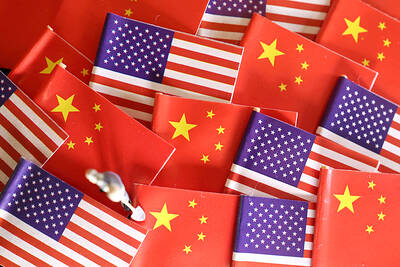The unemployment rate last month rose to its highest level since August last year, as employers offered fewer job openings and more college graduates entered the labor market butfailed to get an offer, the Directorate-General of Budget, Accounting and Statistics (DGBAS) said yesterday.
The unemployment rate — a lagging indicator of economic performance — climbed for the third consecutive month to 4.31 percent last month, from 4.21 percent in June, the agency said in its monthly report.
The seasonally adjusted unemployment rate, which he said was a more reliable indicator of the long-term trend, was up 0.01 percentage points from the previous month to 4.25 percent last month, the report said.
“More school-leavers entered the job market last month, further pushing up the number of first-time jobseekers failing to find a job,” DGBAS deputy director Chen Min (陳憫) told a press conference.
The latest data showed that 490,000 people were unemployed last month, an increase of 13,000 from the previous month, with the number of first-time jobseekers failing to get a job rising by 11,000.
The increase was also reflected in the growing youth unemployment rate, with joblessness among 15-to-24-year-olds rising to 12.96 percent last month, up from 12.36 percent in June and 12.91 percent during the same period last year, the report showed.
Chen said the jobless rate may continue to show a rising trend this month on the same seasonal effect, which may boost the number of first-time jobseekers failing to get a job.
Weak sentiment about the economy would be the other major factor dragging down local employers’ hiring demand and further affecting the labor market in the near future, DGBAS said.
The number of employed people was 10.88 million last month, up 1.21 percent from a year earlier, marking the lowest comparative month-on-month rise in the past two years, which indicated the conservative attitude of employers generating new positions, the agency said.
Henry Ho (何啟聖), a public relations director at 1111 Job Bank (1111人力銀行), also said the continuous downturn trend in the nation’s export orders indicated employers may decrease the number of job openings, further affecting the labor market.
DGBAS also unveiled the latest salary data yesterday, which showed that national monthly salaries averaged NT$37,276 (US$1,240) in the first half of this year, up 1.88 percent from a year ago.
However, when bonuses and other forms of compensation are included, the average monthly remuneration package showed a 0.24 percent markdown from a year earlier to stand at NT$48,829 in the first six months.
This reflected employers awarding lower year-end bonuses and other vocational rewards this year because the global economic slowdown is impacting their businesses, DGBAS said.
In addition, after adjusting for inflation — which climbed 1.47 percent year-on-year in the first six months — real wages fell a further 1.68 percent from a year earlier, data showed.

TECH CLUSTER: The US company’s new office is in the Shalun Smart Green Energy Science City, a new AI industry base and cybersecurity hub in southern Taiwan US chip designer Advanced Micro Devices Inc (AMD) yesterday launched an office in Tainan’s Gueiren District (歸仁), marking a significant milestone in the development of southern Taiwan’s artificial intelligence (AI) industry, the Tainan City Government said in a statement. AMD Taiwan general manager Vincent Chern (陳民皓) presided over the opening ceremony for the company’s new office at the Shalun Smart Green Energy Science City (沙崙智慧綠能科學城), a new AI industry base and cybersecurity hub in southern Taiwan. Facilities in the new office include an information processing center, and a research and development (R&D) center, the Tainan Economic Development Bureau said. The Ministry

ADVERSARIES: The new list includes 11 entities in China and one in Taiwan, which is a local branch of Chinese cloud computing firm Inspur Group The US added dozens of entities to a trade blacklist on Tuesday, the US Department of Commerce said, in part to disrupt Beijing’s artificial intelligence (AI) and advanced computing capabilities. The action affects 80 entities from countries including China, the United Arab Emirates and Iran, with the commerce department citing their “activities contrary to US national security and foreign policy.” Those added to the “entity list” are restricted from obtaining US items and technologies without government authorization. “We will not allow adversaries to exploit American technology to bolster their own militaries and threaten American lives,” US Secretary of Commerce Howard Lutnick said. The entities

Minister of Finance Chuang Tsui-yun (莊翠雲) yesterday told lawmakers that she “would not speculate,” but a “response plan” has been prepared in case Taiwan is targeted by US President Donald Trump’s reciprocal tariffs, which are to be announced on Wednesday next week. The Trump administration, including US Secretary of the Treasury Scott Bessent, has said that much of the proposed reciprocal tariffs would focus on the 15 countries that have the highest trade surpluses with the US. Bessent has referred to those countries as the “dirty 15,” but has not named them. Last year, Taiwan’s US$73.9 billion trade surplus with the US

The Taipei International Cycle Show (Taipei Cycle) yesterday opened at the Taipei Nangang Exhibition Center, with the event’s organizer expecting a steady recovery in the industry this year following a tough last year. This year, 980 companies from 35 countries are participating in the annual bicycle trade show, showcasing technological breakthroughs and market development trends of the bicycle industry at 3,600 booths, the Taiwan External Trade Development Council (TAITRA, 外貿協會) said in a statement. Under the theme “Ride the Revolution,” the exhibition has attracted more than 3,500 international buyers from 80 countries to preregister for the four-day event, which is expected to